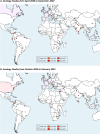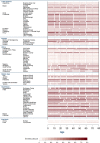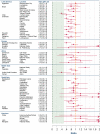Assessing the burden of COVID-19 in developing countries: systematic review, meta-analysis and public policy implications
- PMID: 35618305
- PMCID: PMC9136695
- DOI: 10.1136/bmjgh-2022-008477
Assessing the burden of COVID-19 in developing countries: systematic review, meta-analysis and public policy implications
Abstract
Introduction: The infection fatality rate (IFR) of COVID-19 has been carefully measured and analysed in high-income countries, whereas there has been no systematic analysis of age-specific seroprevalence or IFR for developing countries.
Methods: We systematically reviewed the literature to identify all COVID-19 serology studies in developing countries that were conducted using representative samples collected by February 2021. For each of the antibody assays used in these serology studies, we identified data on assay characteristics, including the extent of seroreversion over time. We analysed the serology data using a Bayesian model that incorporates conventional sampling uncertainty as well as uncertainties about assay sensitivity and specificity. We then calculated IFRs using individual case reports or aggregated public health updates, including age-specific estimates whenever feasible.
Results: In most locations in developing countries, seroprevalence among older adults was similar to that of younger age cohorts, underscoring the limited capacity that these nations have to protect older age groups.Age-specific IFRs were roughly 2 times higher than in high-income countries. The median value of the population IFR was about 0.5%, similar to that of high-income countries, because disparities in healthcare access were roughly offset by differences in population age structure.
Conclusion: The burden of COVID-19 is far higher in developing countries than in high-income countries, reflecting a combination of elevated transmission to middle-aged and older adults as well as limited access to adequate healthcare. These results underscore the critical need to ensure medical equity to populations in developing countries through provision of vaccine doses and effective medications.
Keywords: COVID-19; Epidemiology; Public Health; Serology; Systematic review.
© Author(s) (or their employer(s)) 2022. Re-use permitted under CC BY-NC. No commercial re-use. See rights and permissions. Published by BMJ.
Conflict of interest statement
Competing interests: None declared.
Figures









References
-
- Ramachandran S, Malani A. All-Cause mortality during SARS-CoV-2 pandemic in India: Nationally-representative estimates independent of official death registry. medRxiv 2021;2021. 10.2139/ssrn.3894713 - DOI
-
- Deshmukh Y, Suraweera W, Tumbe C. Excess mortality in India from June 2020 to June 2021 during the COVID pandemic: death registration, health facility deaths, and survey data. medRxiv 2021;2021.
Publication types
MeSH terms
LinkOut - more resources
Full Text Sources
Medical
